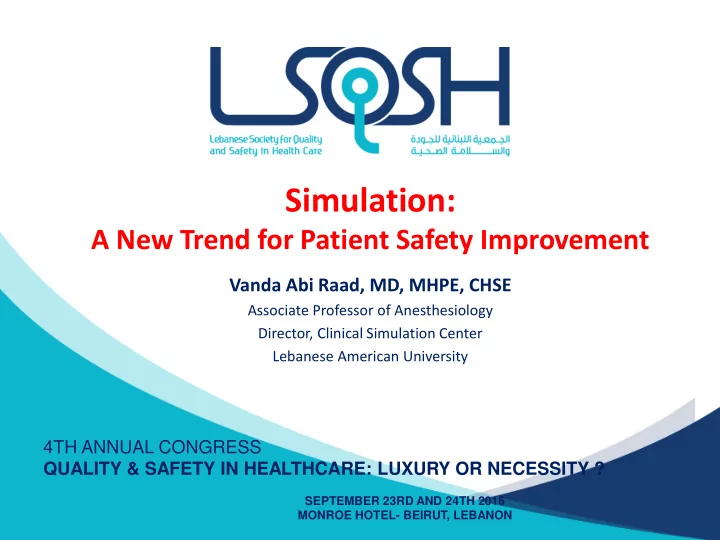

Simulation: A New Trend for Patient Safety Improvement Vanda Abi Raad, MD, MHPE, CHSE Associate Professor of Anesthesiology Director, Clinical Simulation Center Lebanese American University 4TH ANNUAL CONGRESS QUALITY & SAFETY IN HEALTHCARE: LUXURY OR NECESSITY ? SEPTEMBER 23RD AND 24TH 2016 MONROE HOTEL- BEIRUT, LEBANON
Objectives Reflect on the healthcare simulation ‘movement’ and its drivers Describe the basic terminology in simulation and types of simulators Discuss the key elements in Simulation-Based Education (SBE) Discuss the use of simulation for team training List the advantages and limitations of SBE Discuss the evidence of SBE
LA LAU-CSC: Sim imula lation for Education and Patie ient Safety http:/ ://csc.la lau.e .edu.lb lb LAU-SOM Byblos campus
Recognition of the Value of Simulation Aviation, military, NASA, nuclear etc.. • Simulation used and in many cases now required • Adopted as a matter of necessity and expediency • Now culturally embedded e.g. Federal Aviation Administration (FAA) requirement for pilot simulation
What is Simulation Based Education? SBE is an instructional process that substitutes real patient encounters with artificial models, live actors, or virtual reality patients. Gaba, 2004 " Gaba DM. The future vision of simulation in health care. Qual Saf Health Care. 2004;13(suppl 1):i2-i10.
Why To Consider SBE?
Typical Uses of SBE Psychomotor skills Physical exam Clinical reasoning Communication and teamwork skills Communication skills
Simulation Modes / Goals-Tools Match "Miracle on the Hudson"
Simulation Fidelity Fidelity = the level of realism and not necessarily reflect the degree of technology
Features of Effective Simulation Clinical Team Variation Training Mastery Feedback learning Integrated Increasing into overall Difficulty curriculum Individualiz Deliberate ed Practice learning Motola I, et al . Simulation in healthcare education: A best evidence practical guide. AMEE Guide No. 82. Medical Teacher 2013. 35: e1511-30. Issenberg S, et al . Features and uses of high-fidelity medical simulations that lead to effective learning: a BEME systemic review. Medical Teacher, 2005;27:10-28.
Team Training • Team training allows practitioners from ≠ disciplines to improve clinical skills • Team training helps to avoid miscommunication, which is a huge source of error in healthcare delivery Information Exchange: Communication contributes to nearly 2/3 of sentinel events because effective communication does not come naturally Fernandez et al. Developing expert medical teams: Toward an evidence-based approach. Acad Emerg Med 2008. 15: 1025-36 http://www.jointcommission.org/assets/1/18/Root_Causes_Event_Type_04_4Q2012.pdf
CRM Crisis Resource Management Implementation of traditional CRISIS algorithms by well trained TEAMS of HealthCare professionals working with Drugs and Equipment they understand. Ex: Anesthesia Crisis Resource Management
TeamSTEPPS 13
What Does it Take for Simulation-Based Training be Effective for Patient Safety? Salas et al. Using Simulation-Based Training to Improve Patient Safety. What does it take? Journal on Quality and Patient Safety, 2015
Conceptually, simulation training makes sense. What is the evidence? Does the use of SBE results in transferability to better patient care outcomes and reduced complications/morbidity? There is limited but growing evidence that simulation training can translate to improved overall patient care. This limitation is due to: • Relatively new focus on simulation as an educational tool. • Many of the important questions in SBE and assessment cannot be answered by traditional randomized controlled trials. Okuda et al. The utility of simulation in medical education: what is the evidence? Mt Sinai J Med 2009 Aug;76(4):330-43
Simulation Based Education: What is the Value? • Must consider costs of: Simulator, faculty time, training expenses, facility fees, opportunity cost • Cost reporting is infrequent and incomplete- No study has offered a complete accounting of simulation costs • More expensive simulators are not necessarily better Low-fidelity, low-cost training models can yield outcomes equal to much more expensive simulators • Zendejas B et al. Cost: the missing outcome in simulation-based medical education research: a systematic review. Surgery. 2013;153:160-176. • Norman G et al. The minimal relationship between simulation fidelity and transfer of learning. Med Educ. 2012;46:636-647.
ADVANTAGES DISADVANTAGES • No threat to patient safety Resource intensive High degree of realism • High staffing ratio Low educator/learner ratio • Anxiety of learner interferes with performance Active involvement of learner • Learner’s disbelieving attitude or Consistent experience for all students hypervigilance Creates a standardized setting for • Lack of comfort with simulator as enhancing critical-thinking, problem- teaching strategy for educators solving, and decision making skills • No clear validation of transfer of Practice communication with learning to clinical setting multidisciplinary team members Psychomotor skills can be applied and refined
Ideal areas for SBE • Technical Skills - common and uncommon • Physical examination • Team performance • History taking skills and Problem-solving Pitfalls • Simulation is not « THE » objective • Unique session of simulation • Appropriate level of difficulty for the learner • Technology and high-fidelity ≠ successful learning experience Motola, I et al (2013). Simulation in healthcare education: A best evidence practical guide. AMEE Guide No. 82. Medical teacher , 35 (10), e1511 – 30.
Conclusion • Simulation Based Education is important and is here to stay • To optimize both the learning and assessment experience of simulation, remember: o Principles of effective simulation o Advantages /Disadvantages of simulation o Goals-tools match: most important limitation Get started!
Recommend
More recommend